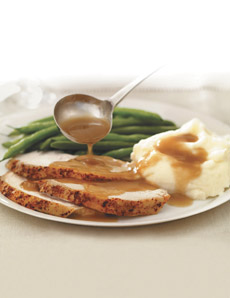TIP OF THE DAY: How To Cook A Moist Turkey
|
One of the biggest challenges of making a turkey is the difference in cooking time between the white meat and the dark meat.
Some people try to keep the white meat moist by tenting it with aluminum foil, or adding a pan of water to the oven. THE NIBBLE’s consulting chef, Eric Dantis, is a pro at cooking turkey. His technique to keep the breast from drying out is simple, especially if you carve the turkey before bringing it to the table (as opposed to showcasing the roasted turkey before carving). The tip: Simply cut the legs off and roast them in a separate pan. It’s simple science: With such a long and slow cooking process, the breast will reach serving temperature of 165°F way before the legs will. As the breast remains in the oven so the legs can finish cooking, it leaks valuable juices, causing the meat to dry out. |
 Our chef’s trick will keep your breast meat moist. Photo courtesy McCormick.com. |
|
|
Some people flip the bird mid-roast, so that the juices flow down into the breast, which is now on the bottom. With a large, hot bird, this can be tricky—if not outright dangerous. So, roast the legs in a separate pan. This way, when the body of the turkey is finished cooking, you can remove it let the legs continue to cook while the body rests before carving. Your turkey will cook faster, the breast will remain moist, and the legs will be tender. Roast on! FOOD TRIVIA: WHERE DID THE TURKEY ORIGINATE? The turkey is a native American, domesticated by ancient Mesoamericans from the wild turkeys of what is today Central Mexico. The meat and eggs were major sources of protein; the feathers were used for ornamentation. The Spanish conquistadors brought turkeys to Spain around 1528. In a turn-about, England sent domestic turkeys back to the Americas—to the Jamestown Settlement in Virginia, in 1607. Here’s more on the history of the turkey.
|
||


